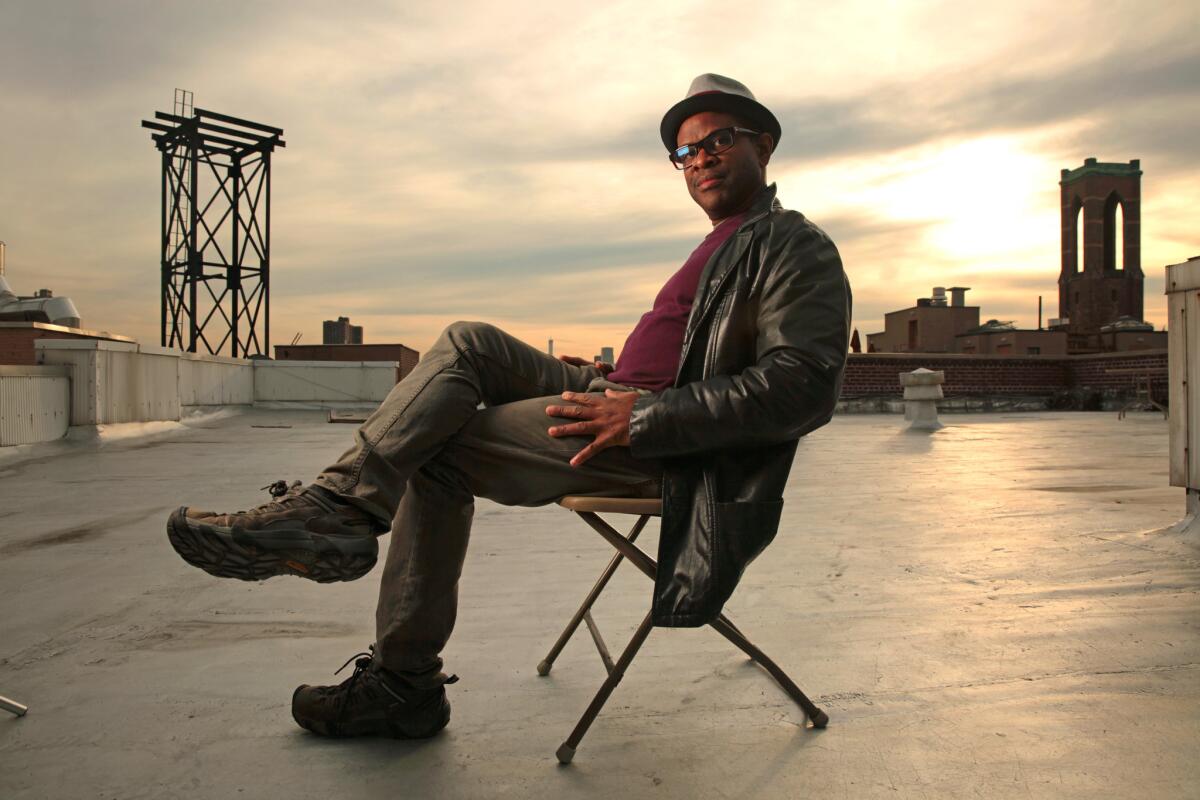Scrapbooks and racial histories tell America’s story in PBS’ ‘Family Pictures USA’

- Share via
In a time of rage and racial division, filmmaker Thomas Allen Harris has been traveling the country and thumbing through family scrapbooks for a documentary that reveals how intertwined Americans are through shared histories and defining struggles that stretch from Southern plantations to Detroit car factories.
The three-part pilot series, “Family Pictures USA,” will premiere on PBS on Monday. Its creed of inclusion plays as antidote for a nation reeling from mass shootings and deepening prejudice. Itinerant and inquisitive, Harris coaxes families to unearth their pasts and hold up faded photographs to show that this land of immigrants, slave descendants and Native Americans can rise above its legacy of cruelties.
“Family Pictures USA” is the latest work in Harris’ long fascination with how images shape narratives and identities. His film “Twelve Disciples of Nelson Mandela” tells the story of his stepfather, a South African exile and supporter of the anti-apartheid African National Congress. That was followed by “Through a Lens Darkly,” an examination of how photographs and advertisements perpetuated stereotypes against blacks.
Set in Detroit, Durham, N.C., and southwest Florida, the PBS series is an extension of Harris’ Digital Diaspora Family Reunion, which traces personal histories as a way to cultural understanding. “Family Pictures USA” visits landmark moments, including the Underground Railroad, World War II, the rise of car manufacturing, the spread of unions and the blast of Motown music.
But the big names from history books are seldom mentioned. Instead, we get the America of the everyman and everywoman — Prussian bricklayer, Jewish cigarette roller, black poet, Polish immigrant, Native American heritage keeper, and the fate of Henry the Hatter, Detroit’s oldest hat shop. They are all connected, sometimes by DNA, and the stories Harris tells us are a chorus of resilience, inventiveness and common purpose that built a striving, if imperfect, nation.
The following is a conversation with Harris edited for clarity and space.
Was it easy to get people to share their family histories and photographs?
They were very eager to tell their stories. They’ve been living with these images for generations. They’ve told their kids these stories umpteen times, but they never had an opportunity to share these stories with anyone else. This project validates their family stories. They’re rooted in images that represent a marker in their lives. It’s extraordinary for them to share it.
Many of these stories are about community. Where people come from, where they settle, where they end up with their identities and aspirations. It’s a retracing of the American experience.
They’re origin stories. Stories of how people survived transitions and transformed themselves through economic challenges. They’re stories of accomplishments. The first [one to go to] college. The first time off the farm, especially in North Carolina. That was huge. I had no idea there were so many stories of moving from the tobacco farm to a city. I’m familiar with that story from Hollywood films about the 1930s or African films of the ‘70s. But these [family album] stories give you a slice of America. A lot of stories are fenced around resilience. People tear up when they share them. They have a feeling around that story. They may not be aware of that feeling, but it emerges when they’re holding the picture up and we capture that moment. That emotional truth is critical to the project.
This series also deals with the legacy of racism and how, notably in the North Carolina episode, people are connected not only by history but by DNA. What was it like exploring that uncomfortable part of American history?
We shared these stories in a multiracial context. For instance, we took Jaki Shelton Green and [her cousin] Sterling Michael Holt back to the plantation and to the descendants of the family that owned their ancestor. Jackie said it was important for her coming back to make sure they know that my story is part of this story. That she was not simply an appendage, but that they hear and acknowledge her story. It felt like there was a transformational moment. There were tears. It felt like my film “Twelve Disciples of Nelson Mandela,” which was very much about reconciliation in South Africa and reconciling my dad’s family album with the people who had stayed behind in South Africa to tell the story. This felt very much like that.
We’ve recently had mass shootings in El Paso and Dayton, Ohio. Our nation is torn by political rancor and battles over who is an American. How does your series speak to a country that is so unsettled?
There is a certain denial of the fact that we Americans are related across racial lines by blood. We’re related across community and economic lines by long family histories and families that needed to survive and who built the country together. We tend to be so ahistorical in America. There’s not a way for us to understand the nuance of who we are and the degree to which we’re blended. People’s histories talk about those truths in a way that is open and honest and irrefutable. It feels right that the series is coming out now because it demands that we acknowledge one another’s humanity. That’s who we are. We have history books that talk about wealthy politicians who were generally male, and generally white patricians, but we have all these other stories and we’re acknowledging their importance. The story is shifting to show that we all have something to add to the pot.
What’s been the most striking thing you’ve learned about America in putting this series together?
There are many. In each location a meta-theme occurs. In Detroit, it was the automobile industry and how that shifted the demographics of that city and the rise of the labor movement, which were depicted in family albums. Another meta-theme was how many women entrepreneurs there were in the photo albums going back to the 1800s. That’s something I couldn’t have predicted. In southwest Florida, so many Indian Seminole people were in family albums. There are so many Seminole images in European American people’s histories and how blended we are in general. In North Carolina, it was the intertwining of the black and white stories. What comes through is the resilience of people and how amazingly diverse this country was and is.
‘Family Pictures USA’
Where: KOCE
When: 9 p.m. Monday; 8 and 9 p.m. Tuesday
Rating: TV-PG (may be unsuitable for young children)
More to Read
The complete guide to home viewing
Get Screen Gab for everything about the TV shows and streaming movies everyone’s talking about.
You may occasionally receive promotional content from the Los Angeles Times.







